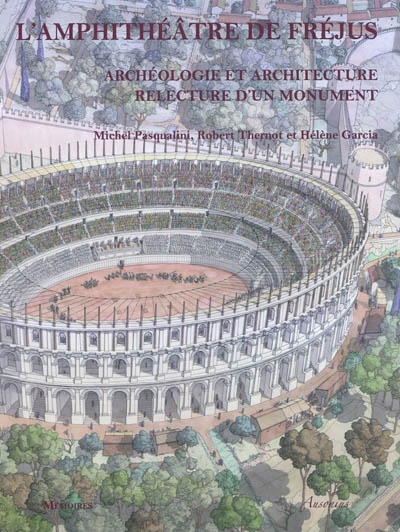en savoir plus

Carte fidélité
Permet à tous ses détenteurs d'obtenir 5% de réduction sur tous les livres lors du retrait en magasin (réduction non cumulable avec les réductions de type étudiant).
Offre également un certain nombre d'avantages auprès de nos partenaires.
Wishlist
Avec les favoris, retrouvez dans un espace les sélections effectuées au fur et à mesure de vos navigations dans le site.
Constituez pour votre usage personnel vos listes de livres en prévisions d'achats futurs et votre sélection d'articles, dossiers, événements, vidéos ou podcasts préférés ou à découvrir plus tard...
Il suffit simplement de cliquer sur "Ajout Favori" sur chaque page qui vous intéresse pour les retrouver ensuite dans votre espace personnel.
Requiert un compte Mollat
Mes Alertes
Requiert un compte Mollat
L'amphithéâtre de Fréjus : archéologie et architecture, relecture d'un monument
en savoir plus
Résumé
Monument emblématique de la ville actuelle de Fréjus, l'amphithéâtre est adossé au promontoire rocheux sur lequel la ville antique a été édifiée. Les fouilles archéologiques et une nouvelle analyse architecturale réalisées en 2006-2007 étaient un préalable aux travaux de conservation et de mise en valeur exécutés dans la cadre du "Plan Patrimoine Antique". ©Electre 2025
Lire la Quatrième de couverture
Réduire la Quatrième de couverture
L'amphithéâtre de fréjus
Archéologie et architecture
Relecture d'un monument
Monument emblématique de la ville actuelle de Fréjus, comme probablement déjà de la ville gallo-romaine de Forum Iulii, l'amphithéâtre est adossé au promontoire rocheux sur lequel la ville antique a été édifiée, à l'extérieur de l'enceinte. Aujourd'hui, son état de conservation nous prive du dernier niveau de gradins, du portique le couronnant et de la façade. Les fouilles archéologiques et une nouvelle analyse architecturale, réalisées en 2006-2007, étaient un préalable aux travaux de conservation et de mise en valeur exécutés dans le cadre du « Plan Patrimoine-Antique ».
Ainsi, il apparaît aujourd'hui que ce grand édifice de spectacle, qui pouvait accueillir près de 10 000 spectateurs, ait été bâti au plus tôt au début du IIe siècle. L'existence d'un édifice antérieur est encore à démontrer, malgré la présence d'aménagements et de constructions plus anciennes. La configuration de la façade extérieure a été précisée grâce à la fouille des fondations et à la découverte (...) blocs provenant de son démantèlement. Les techniques de construction et de mise en oeuvre leur adaptation au site ont été revues. Pour la première fois, l'organisation du chantier apparaît dans la mise en évidence du phasage de la construction. En revanche, pour ce qui concerne le fonctionnement de l'amphithéâtre certains éléments, comme la gestion de l'eau, restent pour partie énigmatiques alors que la fonction et la forme des espaces, telles que la tribune officielle, (...) principale et les circulations dans le monument, ont été précisées.
A symbolic landmark of modern day Fréjus as it must have been of the Gallo-Roman city, the amphitheatre was built outside the town wall, against the North West corner of the rocky outcron on which the Roman town was laid out. Today it stands without its top tier of seating. Its crowning portico and its facade are missing as well. The archaeological excavations and a new architectural study that were carried out in 2006/2007 were the starting point of a conservation and upgrading programme which was part of the project « Plan Patrimoine Antique ».
It is likely that this impressive entertainment complex, which could accommodate about 10 000 spectators, was built no earlier than the beginning of the second century AD. Although evidence of previous building activity has been found, it is not clear yet whether there was an earlier amphitheatre on this site. The configuration of the external façade was determined by the evidence from the excavation of the foundations and the recent discovery of blocks of stone that had been quarried during the dismantling of the amphitheatre. The building techniques and masonry work together with their adaptation to the topography of the site were reassessed. For the first time the organisation of the building site became apparent as we found evidence of the sequence of the different building phases. However, certain aspects of how the amphitheatre functioned remain unsolved ; we still need to elucidate some elements of the water drainage system. Nevertheless, we have been able to determine the function and the shape of areas such as the box for the presiding dignitaries, the main entrance way and how the flow of people inside the monument was coordinated.
Fiche Technique
Paru le : 08/07/2010
Thématique : Préhistoire
Auteur(s) : Non précisé.
Éditeur(s) :
Ausonius
Collection(s) : Mémoires
Contributeur(s) : Directeur de publication : Michel Pasqualini - Directeur de publication : Robert Thernot - Directeur de publication : Hélène Muntal-Garcia - Préfacier : Xavier Delestre
Série(s) : Non précisé.
ISBN : 978-2-35613-027-3
EAN13 : 9782356130273
Reliure : Relié sous jaquette
Pages : 226
Hauteur: 29.0 cm / Largeur 22.0 cm
Épaisseur: 2.0 cm
Poids: 1220 g
